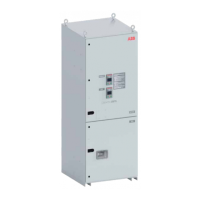2
89
34ZBTS_30-1200A rev.A / 1SCC303043M0201
3
Connections
The module must be mounted on a DIN
rail, and connected by wiring the connec-
tors on the module. With communication
via Local Bus, the communication lines on
the module must be connected to the cor-
responding lines on the power supply
module of the switch. On the contrary,
with communication via Link Bus, the Link
Bus connector on the module must be
connected to an Ethernet switch.
9.3.1 Wiring
The power supply of Ekip signalling 10K
module is taken directly from PCBA termi-
nals X14: 5 (+24V DC) and X14: 6 (-24V DC)
located on the control plate (back side).
These terminals are ready for use in 24V
DC supply. Figures show the wiring route
example.
For the wirings:
• For the Local Bus, Belden type 3105A or
equivalent cables must be used, that is
with a pair of twisted and shielded ca-
bles, with a characteristic impedance
must be connected to earth on one side
of the connection, on the trip unit side.
The maximum recommended length for
the connection is 15 m.
• For communication via Link Bus, a cable
of type Cat.6 S/FTP must be used (Cat.6
with S/FTP double shielding).
—
Fig. 9.6 The power supply for Ekip Signalling 10K module
can be taken directly from PCBA terminals X14: 5 (+24V
DC) and X14: 6 (-24V DC) located on the control plate (back
side), see upper picture. The red lines are wiring rotes.
The lower picture is the front side of the control plate,
where Ekip Signalling 10K module will be installed. The
power supply taken from PCBA will be connected to the
terminals DC IN + and DC IN - of Ekip Signalling 10K module
X14: 5 (+24V DC)
X14: 6 (-24V DC)
DC IN + (+24V DC)
DC IN - (-24V DC)
9.3.2 Outputs, inputs and signals
The outputs and the inputs are accessible
on the connectors positioned on the front
of the module. Table 9.1 illustrates the
pins of these connectors. Table 9.2 illus-
trates the signals related to the outputs,
and their meaning. Table 9.3 illustrates
the signals related to the inputs, and their
meaning.
—
Fig. 9.7 Ekip Signalling 10K module, connection diagram

